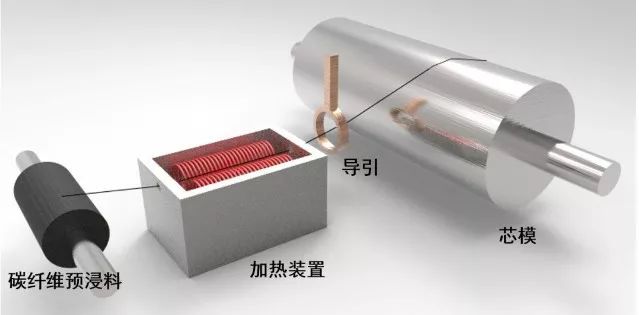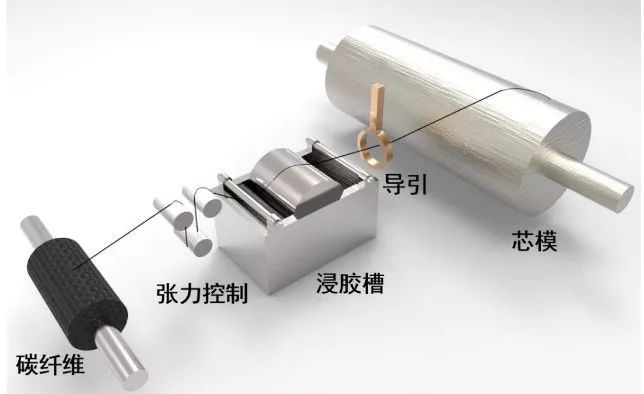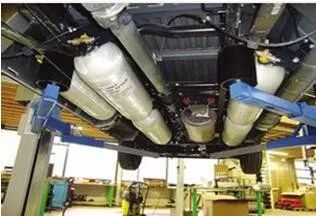Carbon Fiber Gas Cylinder Manufacturing Process
30 March 2023Carbon Fiber Gas Cylinder Manufacturing Process
High pressure gas cylinders, common oxygen cylinders, fire extinguishers, liquefied gas cylinders, and so on, are also made of a single material, such as aluminum and steel. The composite material is basically a metal material wrapped with a layer of carbon fiber, fiberglass, and other materials.
Material: T700 carbon fiber, 6061 aluminum alloy metal lining, outer diameter 404mm, total length 668mm, barrel section thickness 1.6mm
Process: CNC winding machine is used to wind and form composite gas cylinders on the surface of the metal lining. After the winding is completed, the composite material thickness of the cylinder section is 10mm, and the composite material is rotated and solidified in an oven.
Winding Forming Process for High Pressure Gas Cylinders:
In the process of processing high-pressure gas cylinders, CFRP mostly uses carbon fiber winding technology. During the process of carbon fiber winding and molding, carbon fiber bundles are continuously wrapped around the rotating mandrel under tension, gradually forming a cylindrical structure.
There are two types of filament winding processes used for CFRP in high-pressure gas storage bottles:
The first is dry winding, which uses prepreg tape treated with prepreg as the raw material, and then heats and softens it to a viscous flow state on a winding machine before winding it onto the core mold.

The second is wet winding, which refers to the process of directly impregnating carbon fiber bundles in a specific impregnation device, and then winding them onto the core mold under tension control.

In wet winding, it is easy for fibers to take resin out after leaving the impregnation device, resulting in resin waste. To avoid this phenomenon, the wet winding speed is often relatively slow. At the same time, due to the continuous loss of resin, it is difficult to control the ratio of resin to carbon fiber, and generally, the solvent volatilization in the wet winding process can lead to odor in the working environment.
In addition to the obvious disadvantages mentioned above, wet winding process also has some significant advantages compared to dry winding: first, the production cost is lower, about 40% lower than dry winding; Secondly, the product has good air tightness. During the winding process, the excess resin can be controlled by tension to squeeze out bubbles and fill the gaps overnight; Finally, during wet winding, the resin glue impregnated on the surface of carbon fibers can effectively reduce fiber wear.
In fact, in terms of cost alone, wet winding has obvious advantages, so it is currently the most commonly used processing process for high-pressure gas storage bottles.
So what does this gas bottle contain?
The structure of carbon fiber composite pressure vessels mainly includes an inner lining layer and a carbon fiber composite material layer. The main functions of the inner lining are storage, leakage prevention, and chemical corrosion prevention, while the composite material layer is the main carrier of pressure.
The carbon fiber composite material layer is composed of carbon fibers and a matrix, wherein the carbon fibers are the reinforcing phase, and the matrix can transfer loads, solidify, and protect the carbon fiber material. A carbon fiber composite pressure vessel is obtained by winding the carbon fiber soaked in the resin glue overnight onto the inner liner in a specific manner, and undergoing curing, self tightening, and other processes.
Since the advent of carbon fiber reinforced aluminum alloy lined pressure vessels in the 1980s, great progress has been made in the research of carbon fiber composite pressure vessels, and their applications have become increasingly widespread.
Currently, the main applications of carbon fiber composite pressure vessels include: medical respiratory systems, including domestic and medical oxygen respirators, self-contained positive pressure air respirators for fire protection, and compressed oxygen circulatory respirators for rescue purposes; Aerospace field, including inflatable devices for escape slides of missile launchers, ejection seats, and housings; The field of new energy vehicles includes compressed natural gas storage cylinders such as steel lined carbon fiber circumferential wound steel composite gas cylinders (CNG-2), aluminum lined carbon fiber fully wound composite gas cylinders (CNG-3), plastic lined fully wound composite gas cylinders (CNG-4), and high-pressure hydrogen storage pressure vessels.
Spiral wound high-pressure gas cylinders have the advantages of being lighter than steel cylinders with the same volume and pressure bearing capacity, good corrosion resistance, and no pollution to the filling medium, making them widely used in automobiles, aviation, medical health, family health care, fire protection, mine rescue, gas analysis, and special equipment.




